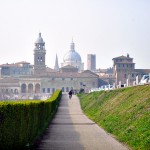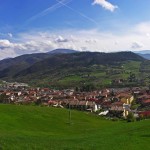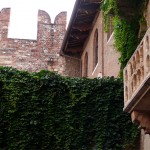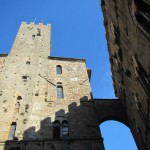The perfect destination for a romantic and cultural weekend
Welcome to Todi: the ideal city
According to a study by University of Kentucky
We are in Todi, in the Italian region Umbria, in the very centre of Italy. The countryside and the hills around here are beautiful. The city blends in perfectly with the landscape. Todi is part of the Italian countryside par excellence.
There’s a national park through which an important river flows. There are many churches, big and small. There are houses with their own tiny vegetable plots. Then there’s the city centre, steeped in so much history.
A study conducted by the University of Kentucky in 1990 revealed Todi to be the ideal city! There is a perfect balance between farming, art, culture and food.
It was already famous for being the birth place of Jacopone, who came to be known as Jacopone da Todi.
⇒ Watch the full web serie “Slow Tour in Umbria”
Main pic courtesy of Andrea Passoni (Flickr User AndrePax)
Video full text: Todi
We are in Umbria, and this is where you can really use a wide angle lens,
take panoramic views and widen the shot –
it’s all so beautiful!
The countryside and the hills are beautiful,
the city blends in perfectly with the landscape: Todi.
Todi is part of the Italian countryside par excellence.
There’s a national park through which an important river flows.
There are many churches, big and small, and houses with their own tiny vegetable plots.
Then there’s the city centre that is steeped in so much history.
A study conducted by the University of Kentucky in 1990 revealed Todi to be the ideal city
because of the perfect balance that exists between farming, art, culture and food.
The New York Times reported on the information and so Todi became famous.
It was already famous for being the birth place of Jacopone, who came to be known as Jacopone da Todi.
Here’s an image of Jacopone on a bas-relief dating from 1930 that marks the seven hundredth anniversary of his birth.
Jacopone seeks to atone for the sins of humankind through penitence.
His bizarre behaviour led him to being referred to as Christ’s madman.
It’s possible to tell the history of a city from its fountain!
The water comes from a hill via a tunnel built by the Umbrians.
The eagle is the symbol of the city of Todi.
Originally Todi was to have been built along the banks of the River Tiber.
Legend has it that while its founders were taking a midday break
an eagle stole the tablecloth and carried it to the top of the hill.
And that is where Todi was built.
But how dependable is this legend about the city’s foundation?
There is another version which says that there were two lovers by the side of the river.
This time the eagle is said to have taken the young woman’s clothes.
She then supposedly ran naked up the hill where she joined in carnal union with her lover.
This episode led to the symbolic foundation of the city.
There is a piece of evidence to support this clandestine version of the tale.
A bas-relief close to the church of San Silvestro that depicts Adam and Eve.
It all makes sense!
So now let’s go inside the church of San Silvestro.
Here we find the painting of Jacopone da Todi in prayer.
Before becoming a blessed Franciscan he was a great poet.
His lauds, written in vulgar Italian, preceded the works of Dante Alighieri.
He was one of the young spiritual friars who were at variance with the conventuals, whom they considered were not sufficiently penitent.
Jacopone doesn’t even have any sleeves!
He was the standard bearer for Franciscan spirituality and
he clashed with one of the most famous Popes in Church history – Boniface VIII.
Jacopone doesn’t even have a halo –
an act of rebellion against the official Church.
Now let’s go to San Fortunato, a wonderful example of Gothic architecture.
Beneath the high altar is the crypt, the burial place of Jacopone da Todi.
The date on the tombstone is deliberately incorrect, i.e. 10 years before his death.
This was prior to his having been excommunicated by Boniface VIII.
Poor old Jacopone, he was mystical!
He didn’t die in 1296 but in 1306! Here’s his tomb.














